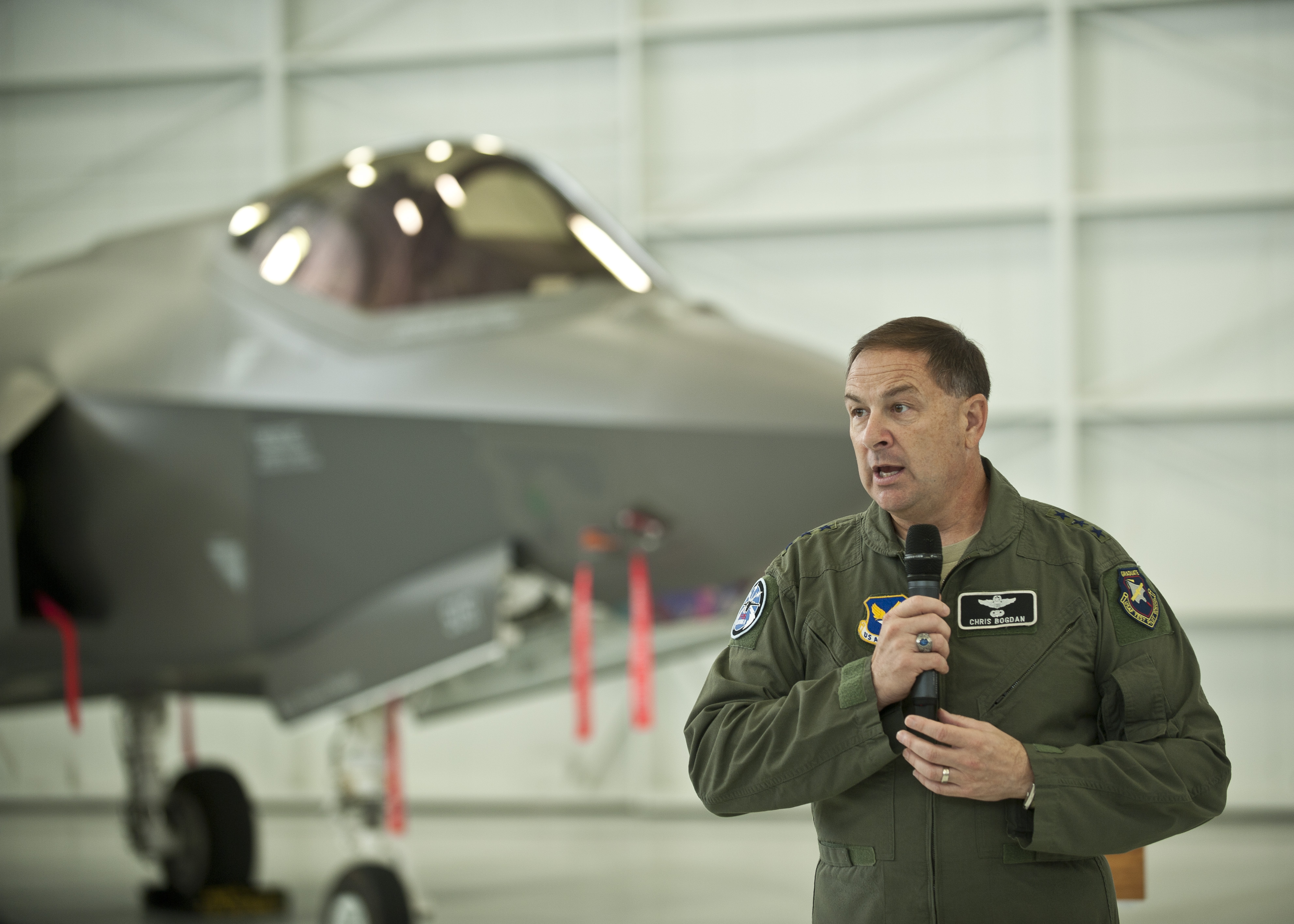Lt. Gen. Christopher C. Bogdan, the program executive officer for the F-35 Lightning II Joint Program Office, speaks to airmen and civilian employees who work on the F-35A Lightning II at Nellis AFB, Nev., Aug. 27, 2015. Air Force photo by SSgt. Siuta B. Ika.
Shortly before taking over the F-35 Joint Program Office in 2012, Lt. Gen. Christopher Bogdan put all the program stakeholders—the services, Congress, international partners, and contractors—on notice that there was a new sheriff in town.
Speaking at AFA’s Air & Space Conference in September of that year, Bogdan made headlines by saying the relationship between Lockheed Martin and the government was “the worst I’ve ever seen” promising “straight talk” about what was then only a slowly improving $1.5 trillion project (now expected to cost about $850 billion).
Bogdan said the JPO would have to “fundamentally change the way we do business with Lockheed Martin,” noting that while its performance was improving, the learning curve and cost just wasn’t coming down fast enough. Five years later, Bogdan—who steps down from the job on Thursday and retires in June—said there’s still a trust issue between Lockheed Martin and the government, and that it must improve for the long run.
Bogdan said he planned those seemingly off-the-cuff comments that day at the AFA conference. His comment about Lockheed was “a factual statement,” but he didn’t warn his many bosses that he was going to be so blunt, knowing “they wouldn’t have wanted me to” and might have “tried to convince me otherwise.”
He spoke directly, even though “right then and there, it could have been over”—meaning he might have been fired—but “I would have been okay with that” because he was convinced that such an attitude “was what was necessary to turn the program around.” The “culture and the behavior was one of the root problems with the program” and had to be shaken up. “And that was my shot across the bow to tell everybody that that was one of the things we needed to fix.” He was gratified that his many bosses let him do it his own way.
Both Service Acquisition Executives—William LaPlante and Darlene Costello in the Air Force, Sean Stackley at the Navy—as well as Pentagon acquisition chief Frank Kendall and former Defense Secretary Ashton Carter and Deputy Defense Secretary Robert Work—“all gave me great support,” Bogdan said. “I will tell you, I went out on a limb sometimes, and I stuck my neck out and created controversy, and I broke some glass and there were many, many times they could have very easily cut my knees out from under me, and they didn’t. And I appreciate that.”
Another time he expected blowback was a comment he made in Australia. “In the midst of negotiating the endgame of Lot 5, I was frustrated with Lockheed,” because after 15 months, “we still weren’t there.” He said “something like, ‘I’m tired of Lockheed squeezing every nickel out of us as if they think this is the last airplane we will ever buy from them.’” It could have “very easily been dealt with differently” by the higher-ups.
Deciding to unilaterally set the price on Lot 9 was another episode where Bogdan was gratified that the Defense Department “wholly supported me.” After 18 months—and seemingly within a breath of signing a deal—something happened that set the negotiations back, which Bogdan wouldn’t discuss on the record, though he said it caused him to simply set a price and halt the discussions. Lockheed ultimately agreed to the “price and terms and conditions” Bogdan set for Lot 9.
So has the relationship improved, five years on? It’s “better, but not good enough,” Bogdan asserted. “I think there’s still a trust deficit, on both sides,” he noted. “We communicate better,” and he believes industry “recognizes that communicating in a very clear, transparent way, even though it’s sometimes painful, gets you to solutions faster, and gets you to the root causes [of problems] and moves the program along better.” But there’s still that suspicion, he said.
“On the government side, we’re still skeptical in some instances that industry would put the warfighter first, over anything else.” On the industry side, “I think they don’t trust government,” and fear “we’re going to take business away from them, in the long term.”
While Lockheed does a lot of contractor logistics support now and would like to get the work on future upgrades, Bogdan said “the natural evolution of every acquisition program I’ve ever seen, especially for airplanes, is that we do move a lot of stuff organically,” meaning, the Air Force will do its own maintenance, logistics, and support in house. There’s also been a push, especially within the Air Force, to “own the technical baseline” so that upgrades and modifications can be competed, instead of going always to the original prime.
“It’s not to punish industry,” he explained, but “we can’t afford it sometimes,” and sometimes industry itself “has moved on to something else.”
The “natural evolution” of a program “is to move things in-house and organically, and I would think on this program everyone would be better served if we recognize that and plan for it. And I don’t think we have a good-enough relationship to do that, yet.”
Is there a prescription to improving that trust? Bogdan answered, “over time, your actions, and the way you behave, and the things you do will engender trust. It’s not something you can just talk about and have it change right away. You’ve just got to do things for each other and with each other that just build it up.”
